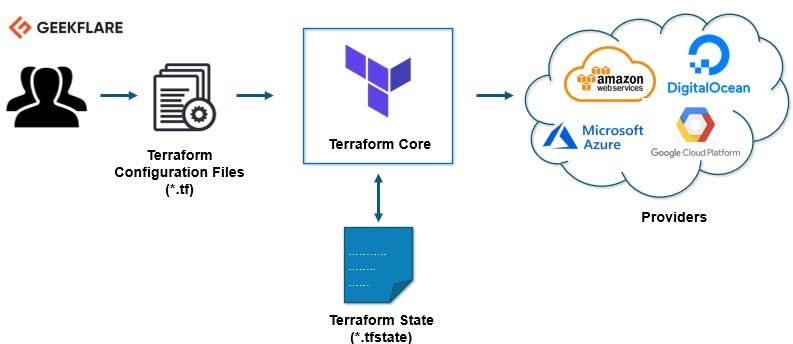Introduction:
Managing infrastructure can be challenging, especially when dealing with complex environments and multiple cloud providers. Terraform, an open-source tool created by Hashi Corp, simplifies this process by enabling Infrastructure as Code (IaC). In this blog, we’ll explore Terraform capabilities, how it compares to other tools, and how you can get started with it.
Terraform:
Terraform is an open-source infrastructure as code software tool developed by Hashi Corp. It allows you to define and provision your entire infrastructure using a high-level configuration language known as HashiCorp Configuration Language (HCL). Terraform ensures that your infrastructure is consistent and repeatable.

Key Features of Terraform:
- Idempotent: You can run Terraform multiple times, and if no updates are needed, it will ignore any changes.
- Multi-Cloud Support: Works with AWS, Azure, Google Cloud Platform (GCP), and many others.
- Declarative Language: Uses HCL for writing infrastructure configurations.
Terraform Basics
Configuration Files
- Files containing Terraform code are called configuration files and typically have a
.tfextension. These files define the resources and infrastructure you want to create.
State File (tfstate)
- The state file (
.tfstate) contains information about the provisioned infrastructure that Terraform manages. It helps Terraform map real-world resources to your configuration, keep track of metadata, and improve performance.
Terraform setup in Workspace
Setup environment variables for terraform
- • Type terraform -v in command prompt
- • Create one directory and start writing terraform files.
- • mkdir Terraform
- • main.tf
- • terraform init
- • terraform fmt
- • terraform validate
- • terraform plan
- • terraform apply
- • terraform apply –auto-approve
- • terraform destroy
Multiple ways to access providers
- Hardcode Access Key & Secret Key directly in main.tf
- Declare variables in main.tf and dynamically enter AK & SK
- Create variables.tf file for declaring variables and create terraform.tfvars file for assigning values of AK & SK
- Terraform profile config
- aws configure –profile Terraform(IAM profile)
Conclusion
- Terraform is a powerful tool that simplifies the management of your infrastructure. By using Infrastructure as Code, you can ensure consistency, version control, and improved collaboration. Whether you are managing a small application or a complex environment, Terraform can help you streamline your processes.
provider "aws" {
region = "us-west-2"
}
module "network" {
source = "terraform-aws-modules/vpc/aws"
version = "latest"
name = "my-vpc"
cidr = "10.0.0.0/16"
azs = ["us-west-2a", "us-west-2b"]
public_subnets = ["10.0.1.0/24", "10.0.2.0/24"]
private_subnets = ["10.0.3.0/24", "10.0.4.0/24"]
}2. Automated Scaling
- Example: An e-commerce platform experiences traffic spikes during sales events. Terraform can be configured to manage Auto Scaling Groups in AWS. When traffic increases, Terraform applies changes to scale up resources automatically.
- Usefulness: Automated scaling ensures optimal resource utilization and cost-effectiveness while providing a seamless user experience during high traffic.
resource "aws_autoscaling_group" "app" {
launch_configuration = aws_launch_configuration.app.id
min_size = 1
max_size = 10
desired_capacity = 2
vpc_zone_identifier = ["subnet-abc123", "subnet-def456"]
}3. Infrastructure Updates
- Example: A SaaS company needs to update its database instance type to accommodate increased load. With Terraform, the team can modify the resource definition and apply changes without downtime, as Terraform manages the state and ensures a smooth transition.
- Usefulness: This capability allows teams to make infrastructure changes with minimal disruption, enhancing application reliability.
resource "aws_db_instance" "default" {
allocated_storage = 20
engine = "mysql"
engine_version = "5.7"
instance_class = "db.t3.medium" # Updated instance type
...
}Multi-Cloud Deployments
- Example: A startup wants to deploy its application across multiple cloud providers (AWS, Azure) for redundancy. Terraform’s provider system allows the team to manage resources in both AWS and Azure using the same configuration language.
- Usefulness: This flexibility enables organizations to avoid vendor lock-in and optimize their cloud strategy based on workload requirements.
provider "aws" {
region = "us-west-2"
}
provider "azurerm" {
features {}
}
resource "aws_instance" "example" {
ami = "ami-12345678"
instance_type = "t2.micro"
}
resource "azurerm_linux_virtual_machine" "example" {
name = "example-machine"
resource_group_name = "example-resources"
location = "West US"
size = "Standard_DS1_v2"
...
}
5.Version Control and Collaboration
- Example: A DevOps team uses Git to manage their Terraform configuration files. Changes to the infrastructure code are tracked, and pull requests facilitate code reviews before applying changes.
- Usefulness: Version control fosters collaboration and accountability, ensuring that infrastructure changes are well-documented and reversible.
Best Practices for Using Terraform in DevOps
- Use Modules: Break down your configurations into reusable modules to promote code reuse and maintainability.
- Remote State Management: Store your Terraform state files remotely (e.g., in AWS S3 with versioning) to prevent conflicts and provide team access.
- Plan Before Apply: Always run
terraform planbefore applying changes to review what modifications will occur, reducing the risk of unintended consequences.
Conclusion
Terraform is a powerful tool that streamlines the management of AWS resources within a DevOps framework. By leveraging Terraform’s capabilities, organizations can automate infrastructure provisioning, adapt to changing requirements in real-time, and enhance collaboration among teams. As the demand for agile and reliable infrastructure grows, adopting Terraform can provide a competitive edge in delivering high-quality software products.ment.
- By admin





